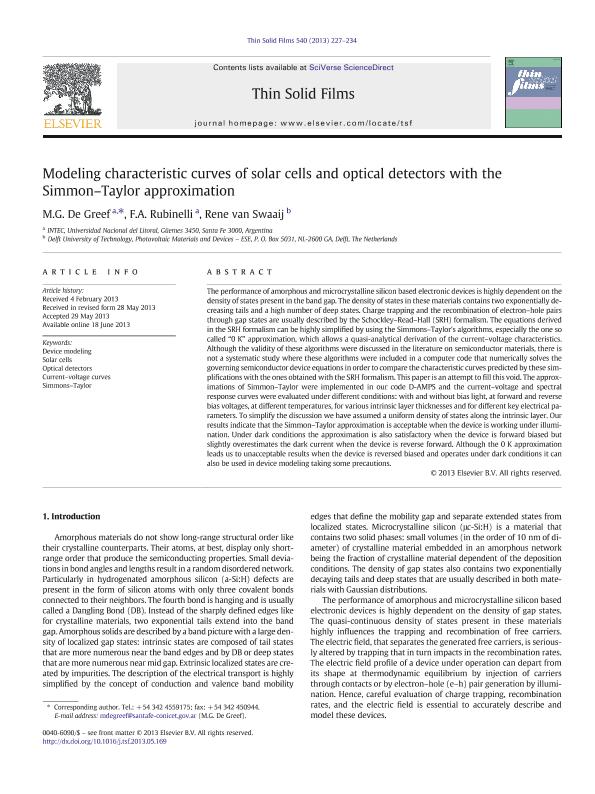Mostrar el registro sencillo del ítem
dc.contributor.author
de Greef, Marcelo Gastón

dc.contributor.author
Rubinelli, Francisco Alberto

dc.contributor.author
Van Swaaij, Rene
dc.date.available
2015-07-06T16:29:43Z
dc.date.issued
2013-08
dc.identifier.citation
de Greef, Marcelo Gastón; Rubinelli, Francisco Alberto; Van Swaaij, Rene; Modeling characteristic curves of solar cells and optical detectors with the Simmon-Taylor approximation; Elsevier Science SA; Thin Solid Films; 540; 8-2013; 227-234
dc.identifier.issn
0040-6090
dc.identifier.uri
http://hdl.handle.net/11336/1027
dc.description.abstract
The performance of amorphous and microcrystalline silicon based electronic devices is highly dependent on the density of states present in the band gap. The density of states in these materials contains two exponentially decreasing tails and a high number of deep states. Charge trapping and recombination of electron-hole pairs through gap states are usually described by the Schockley-Read-Hall (SRH) formalism. The equations derived in the SRH formalism can be highly simplified by using the Simmons-Taylor's algorithms, especially the one so called 0K approximation, which allows a quasi-analytical derivation of the current-voltage characteristics. Although the validity of these algorithms were discussed in the literature on semiconductor materials, there is no a systematic study where these algorithms were included in a computer code that numerically solves the governing semiconductor device equations in order to compare the characteristic curves predicted by these simplifications with the ones obtained with the SRH formalism. This paper is an attempt to fill this void. The approximations of Simmon-Taylor were implemented in our code D-AMPS and the current-voltage and spectral responses curves were evaluated under different conditions: with and without bias light, at forward and reverse bias voltages, at different temperatures, for various intrinsic layer thicknesses and for different key electrical parameters. To simplify the discussion we have assumed an uniform density of states along the intrinsic layer. Our results indicate that the Simmon-Taylor approximation is acceptable when the device is working under illumination. Under dark conditions the approximation is also satisfactory when the device is forward biased but slightly overestimates the dark current when the device is reverse forward. Although the 0K approximation leads us to unacceptable results when the device is reversed biased and operates under dark conditions it can also be used in device modeling taking some precautions.
dc.format
application/pdf
dc.language.iso
eng
dc.publisher
Elsevier Science SA

dc.rights
info:eu-repo/semantics/openAccess
dc.rights.uri
https://creativecommons.org/licenses/by-nc-sa/2.5/ar/
dc.subject
CURRENT-VOLTAGE CURVES
dc.subject
DEVICE MODELING
dc.subject
OPTICAL DETECTORS
dc.subject
SIMMONS-TAYLOR
dc.subject
SOLAR CELLS
dc.subject.classification
Física de los Materiales Condensados

dc.subject.classification
Ciencias Físicas

dc.subject.classification
CIENCIAS NATURALES Y EXACTAS

dc.title
Modeling characteristic curves of solar cells and optical detectors with the Simmon-Taylor approximation
dc.type
info:eu-repo/semantics/article
dc.type
info:ar-repo/semantics/artículo
dc.type
info:eu-repo/semantics/publishedVersion
dc.date.updated
2016-03-30 10:35:44.97925-03
dc.journal.volume
540
dc.journal.pagination
227-234
dc.journal.pais
Países Bajos

dc.journal.ciudad
Amsterdam
dc.description.fil
Fil: de Greef, Marcelo Gastón. Consejo Nacional de Investigaciones Científicas y Técnicas. Centro Científico Tecnológico Conicet - Santa Fe. Instituto de Desarrollo Tecnológico para la Industria Química. Universidad Nacional del Litoral. Instituto de Desarrollo Tecnológico para la Industria Química; Argentina
dc.description.fil
Fil: Rubinelli, Francisco Alberto. Consejo Nacional de Investigaciones Científicas y Técnicas. Centro Científico Tecnológico Conicet - Santa Fe. Instituto de Desarrollo Tecnológico para la Industria Química. Universidad Nacional del Litoral. Instituto de Desarrollo Tecnológico para la Industria Química; Argentina
dc.description.fil
Fil: Van Swaaij, Rene. Delft University of Technology; Países Bajos
dc.journal.title
Thin Solid Films

dc.relation.alternativeid
info:eu-repo/semantics/altIdentifier/doi/http://dx.doi.org/10.1016/j.tsf.2013.05.169
Archivos asociados
